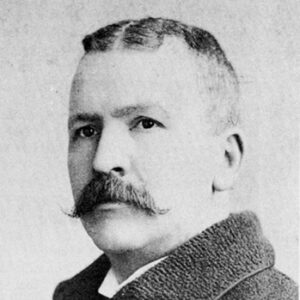calsfoundation@cals.org
Frederick Tanqueray Anderson (1846–1926)
Frederick Tanqueray Anderson was an early twentieth-century Arkansas watercolorist. Categorized as a romantic American Landscape artist, Anderson is known for his steamboat and landscape paintings. Anderson’s paintings were inspired by his boyhood memories of traveling down the Mississippi River with his grandfather on steamboats to New Orleans, Louisiana. According to a Memphis Commercial Appeal article dated May 20, 1945, many regarded Anderson as the leading river scenes painter in America.
Frederick T. Anderson was born on July 1, 1846, on his grandfather’s Arkansas River plantation near New Gascony (Jefferson County). His parents were Richard Cuthbert Anderson, who was a physician, and Hortense Barraque Anderson. Anderson had one older sister, Julia. His grandfather, Antoine Barraque, was one of Arkansas’s more prominent settlers, having served as an officer under Napoleon in France.
Anderson lived in a variety of places during his youth, including Bolivar Township in Jefferson County, New Orleans, and Red Bluff (Jefferson County). In 1870, Anderson moved to Memphis, Tennessee, and began his career as a bookkeeper in the Cotton Exchange. Shortly after his arrival in Memphis, he showcased his painting talent. The Memphis Daily Appeal published an article on August 2, 1874, that described an Anderson painting displayed on the wall of the Cotton Exchange titled Rapidly Ascending the Mississippi, which depicts the steamboat Phlallin’ charging up the Mississippi River at full speed.
In 1878, Anderson married Lula Bruce, a daughter of the prominent Memphian Noble S. Bruce. They had three sons. Though Anderson continued to work in the cotton industry after his marriage, the desire to further his artistic studies took him to Europe in 1889, where he reportedly studied under impressionist painter Camille Pissarro. Returning to Memphis after approximately five years of study abroad, he contributed works to Harper’s Weekly, Leslie’s, and other illustrated magazines of that time.
Unfortunately for Anderson, he painted during a time when Pablo Picasso and other avant-garde artists were gaining acclaim. As a consequence of pursuing an outdated landscape style reminiscent of mid-nineteenth century Hudson School painters such as Thomas Cole and Winslow Homer, Anderson failed to gain significant renown beyond Arkansas and Tennessee—with one exception. President Theodore Roosevelt had traveled to Memphis in 1907 to attend the Waterways Convention and was presented with one of Anderson’s paintings, which the president greatly admired. Upon the receipt of this first painting by Anderson, the president expressed a wish for a second painting, depicting the steamboat New Orleans. The steamboat had been captained by Nicholas Roosevelt, one of the president’s ancestors, in 1811. Shortly thereafter, Anderson painted a depiction of the New Orleans as a surprise gift for Roosevelt.
Anderson’s works have been exhibited three times: at the residence of Edward Craig in Bentonville (Benton County) in 1915; at the Brooks Memorial Art Gallery, now the Memphis Brooks Museum of Art, in 1945; and at the Southeast Arkansas Arts and Science Center in Pine Bluff (Jefferson County), now Arts & Science Center for Southeast Arkansas, in 1983.
Anderson died on November 14, 1926, at the home of his son Lewis in Larchmont, New York. He is buried next to his wife in Memphis’s Elmwood Cemetery.
Though many of Anderson’s paintings are held in private collections, Anderson enthusiasts can view one of his works, The J. N. Harbin’ (1908), at the Arts & Science Center for Southeast Arkansas.
For additional information:
Adams, Hilda. “Frederick Tanqueray Anderson—Artist.” Jefferson County Historical Quarterly 11, no. 3. (1983): 34–41.
F. T. Anderson Gallery. UA Little Rock Exhibits. http://ualrexhibits.org/steamboats/media-gallery/frederick-tanqueray-anderson/ (accessed October 22, 2020).
Kaufman, Charles. “Light Shed on Two Arkansas-born Artists.” Arkansas Gazette, May 13, 1983, p. 11B.
Talley, Robert. “[Th]rilling Events in Story of Memphis and Its Great River Will Live Again in Exhibit of Famed Local Artist’s Paintings at Brooks Memorial Gallery, Due to Begin on May 31.” Memphis Commercial Appeal, May 20, 1945, p. 1.
Kaye Lundgren
UA Little Rock Center for Arkansas History and Culture
 Arts, Culture, and Entertainment
Arts, Culture, and Entertainment Post-Reconstruction through the Gilded Age, 1875 through 1900
Post-Reconstruction through the Gilded Age, 1875 through 1900 Frederick T. Anderson
Frederick T. Anderson 




I purchased a watercolor titled The Jester by F. T. Anderson, dated 1905. It was purchased in Colorado Springs in a Goodwill store around 2002. Beside his name is printed the word “Fragment.” I actually found this original watercolor hidden behind a framed watercolor by Annie Lee Ross. Have been trying for several years to learn more about The Jester. Hoping this post might bring some information forward. I am in Alberta, Canada.